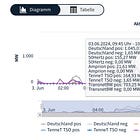Volatility in short-term power markets
Study-notes and reflections
The aim of Stratnergy is to connect across ideas and to prompt opportunities to slow down and reflect. In terms of Isaiah Berlin’s fox/hedgehog dichotomy (“the fox knows many things, but the hedgehog knows one big thing”) this project is more of an attempt at fox-iness, even if, once in a while, this fox might lie down and pretend to be a hedgehog.
So, why does Stratnergy need a “review” or “study note” format?
It’s easy to get stuck in our own views and so it’s important to listen to others, question our assumptions, learn as much as we can. Part of the aim of this project is to get to a point where again and again I realise what I don’t know... In this way, Stratnergy is a bit like the flu-vaccine shot I got this morning: a weekly self-inoculation against the temptation to feel comfortable with what I think I know already.
This is a long prologue already, but there’s a final point to make. The webinar discussed in these study notes was free, but this post requires a subscription, how does that make sense? Well, the webinar had a commercial angle and supported, I presume, product sales. In contrast, this project is driven purely by my personal motivation to invest my own time into learning about the industry and into preparing and offering thoughts out into the wilderness of the internet, like bottles out to sea. The paywall provides a degree of privacy (these are my personal notes, after all) and it functions as a filter for interest, and it might someday even cover the costs I incur to learn about the industry. If you don’t agree with this justification/rationalisation please let me know!
So, let’s begin. This “review post” collects thoughts on yesterday’s Montel webinar on “Navigating volatility in short-term power markets” given by Jean-Paul Harreman, Director of Montel Analytics. Think of this post as an extended attempt to “actively listen” while also letting my own thoughts churn through (usually one of these activities excludes the other, but part of the joy of writing things down is the possibility of such connection).
A link to the recording was sent out afterwards, so if you didn’t have a chance to join you may still be able to get access to the recording by contacting Montel or messaging Jean-Paul Harreman on LinkedIn.
A different version of the talk is available here with slides here. One of the core messages “it’s all about the Deltas” is certainly consistent across these two versions of the talk.
These are my notes and reflections. If you watched the webinar and had different thoughts, please let me know and it’d be good to discuss!
Volatility Trends
The presentation started with the results of a LinkedIn survey question: “What is your biggest worry when making intraday decisions on trading or risk management?” “Information inequality” was by far the most common answer. I wouldn’t have expected that concern too be the most common worry, but it makes sense. There is so much information out there, and some of it, like activation signal information, is available only to some. See also the previous post:
Harreman outlined various factors that contribute to volatility, which I think can be summarised into these two categories:
The build-out of renewables which increases weather-dependency and exacerbates a timing gap between generation and demand
A decrease in flexible fossil generation, and a gap between a demand for flexible assets and supply of flexible assets
The first key takeaway is that in Harreman’s view, volatility is here to stay. Indeed, at the end of the talk in response to a question about the effect of Battery Energy Storage Systems (BESS), Harreman responded:
Do I expect changes in volatility? Not really, but you might see that the edges of the distribution of balancing prices may get closer together. A battery needs a certain spread to make money because they have a limited number of cycles they can run, and so what you will see is that they will nibble at the ends of the price distributions because the larger this capacity gets the closer the ends of the price distributions go together. But at the same time there is a lot of new flexibility needed because of the growth of renewables.
Jean-Paul Harreman, Navigating volatility in short-term power markets, at 58:00 webinar-recording.
Expectations in Time
Everyone who spends some time thinking about the energy markets has a sense of the sequence of information flow. The webinar included an excellent overview of this sequence, linking each element in the structure to factors that relate to volatility. Here is an expanded written version of the graphical overview shown in the webinar.



